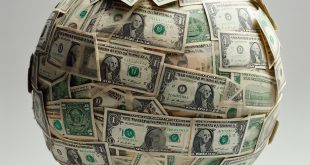Hot inflation, recession-related concerns and quantitative tightening continued to be the major key words dominating financial markets throughout the week as central bankers ponder coming changes of policy based upon the available data particularly the labour market developments.
New U.S. jobless claims fell slightly to 184,000 in mid-April and stayed near a 54-year low, reflecting a tight labor market in which work is easy to find and layoffs are at record lows. New filings for unemployment benefits slipped by 2,000 from 186,000 in the prior week, the Labor Department said Thursday.
Factors like Fed speaking throughout the week increased the appetite for the US dollar. Moreover, rising US Treasury yields underpinned the US dollar, as the 10-year US Treasury yield, the benchmark note, finished at 2.903%, in the week won 2.69%.
IMF’s Gita Gopinath said central bankers must act decisively and quickly to tackle the rise in inflation, Gita Gopinath, first deputy managing director of the International Monetary Fund, said on Friday.
Gopinath, speaking at an IMF event, said there was confidence that central banks would bring down inflation but the time-frame for action was narrow.
Fed Officials’ Comments; Summed Up
On Thursday, Fed Chair Jerome Powell blessed a half-point interest rate increase by the 4-5 May meeting. Meanwhile, money market futures have fully priced in a 0.50% hike to the Federal Fund Rate, which would lift it to 1%.
Later, on Friday and the last Fed speaker before the May meeting blackout, Cleveland’s Fed President Loretta Mester commented that she would like to get neutral to 2.5% by the end of the year. When asked about 75-bps increases, Mester added that “we don’t need to go there at this point”.
St. Louis Fed President James Bullard admitted that the Fed is behind the curve but not as everybody thinks, while adding that the Fed has hiked 75 bps before without the world coming to an end.
San Francisco Fed President Mary Daly noted that the Fed “will likely” raise rates by 50 bps at a couple of meetings. However, according to Yahoo Finance Interview, she is open to deliberating what size of increases are needed.
After another wild week in global money markets, traders are betting big on the biggest regime shift in Europe in years. Fueled by a flurry of hawkish monetary signals over the past week, the interest-rate swaps market now projects the European Central Bank will deliver three quarter-point hikes by December; winding down the eight-year experiment with sub-zero borrowing costs that’s saddled savers with financial repression and helped funnel billions of euros into speculative assets.
Currencies
The US Dollar Index finished the week on a higher note, gaining 0.62%, and ended at 101.118, though short of the 2-year high reached on Friday’s session at 101.331.
Technically; the US Dollar Index (DXY) retains its upward bias, as depicted by the daily chart. The 50 and the 200-day moving averages (DMAs) at 98.487 and 95.459, respectively, are well located under the DXY value, further cementing the upside bias. The Relative Strength Index (RSI) at 67.22 has enough room to spare if the DXY prints another leg up, near January’s 2017 highs around 103.82, before reaching overbought conditions. However, first, the USD would need to overcome some hurdles on its way north.
Gold
The gold price climbed to a five-week high on Monday as the war in East Europe, elevated inflation and the risk of a US recession further bolstered demand for the safe haven asset. Gold advanced 0.7% to $1,988.15 per ounce by noon ET, closing in on the $2,000 level last seen in early March. US gold futures rose 0.8% to trade at $1,991.00 per ounce in New York.
Gold prices fell over 1% on Tuesday as a stronger US dollar and rising Treasury yields overshadowed inflows into the safe-haven metal. By Friday, 22 April, The Gold Price remains downward pressured in the mid-New York session, threatening to break a two-month-old upslope support trendline, which passes on top of the 50-day moving average (DMA) near the $1930-40 area. Factors like continuing hawkishness expressions by Fed officials and higher US Treasury yields weighed on the precious metal price, as XAUUSD is falling some 0.90%, trading at $1933.90 a troy ounce at the time of writing.
Cryptocurrencies
cryptocurrencies remained in an unfortunate spot. Traders may have been enticed to jump the gun following Monday’s rally, which played right into smart money’s game plan as they are still in control of the downtrend. Bitcoin, Ethereum and XRP price could experience severe liquidity hunts if market conditions persist.
Crude Oil
Shipments of Russian crude oil dropped 25% in just a week as the country continues to suffer the economic consequences of its invasion of Ukraine. The shipments translate into an average of 3.12 million barrels of oil per day – down 25% from the prior week that ended April 8.
Crude oil futures were higher in mid-morning Asian trade April 21 amid still tight supply fundamentals, with sentiment receiving an extra boost from draws in US crude and refined product stocks last week.
Total US commercial crude stocks fell 8.02 million barrels to 413.73 million barrels in the week ended April 15, US Energy Information Administration data showed April 20, leaving inventories nearly 15% behind the five-year average for this time of the year.
Crude oil continues to show uncertainty since the surge early in March which took the price close to $1.30 faded and the price fell back below $100. Although, a support zone has formed around the $94-95 level and e have seen two strong bounces from there. Although, buyers have given up and the highs have gotten lower, which means that the buying pressure is fading.
On Friday, crude oil prices reached $105.50, but after FED chairman Jerome Powell signaled aggressive interest rate hikes in the months ahead, oil futures tumbled lower today, giving up some gains from the overnight session as financial markets turned relatively nervous.
Stocks
US equities finished the week with substantial losses, reflecting a gloomy market mood amid concerns that the Fed would hike rates aggressively and high US Treasury yields. The S&P 500, the Dow Jones Industrial, and the tech-heavy Nasdaq Composite nose-dived recording losses between 2.6% and 2.8%, each sitting at 4,271.78, 33,811.40, and 12,839.29, respectively. On Friday, US shares experienced worst day since March on prevalent risk aversion.
European stocks closed lower on Friday after Federal Reserve Chair Jerome Powell said a half-percentage point interest rate increase is “on the table” for next month. The pan-European Stoxx 600 closed down 1.8%, with mining shares slumping 3.6% to lead the losses as all sectors dipped into the red territory. Friday’s trading in Europe comes after a dramatic reversal in stock markets in the U.S. Thursday, with major averages closing lower and wiping out earlier gains.
Globalization and the dominance of the US dollar that ensured Western prosperity and Western global power in the last 76 years, could be weakened or even destroyed by the sanctions US applies on other countries. In course of time, a less hegemonic alternative to the US-led financial system worked out by less powerful countries, might replace the existing system.
Dow Jones futures rose Thursday morning, along with S&P 500 futures and especially Nasdaq futures, with Tesla earnings in focus. The stock market rally was split Wednesday, with the Dow Jones breaking above key levels while the Nasdaq composite hit notable resistance as FANG stocks Netflix and Facebook plunged.
The week ahead in the US docket
The economic calendar for the US would feature March’s Durable Goods Orders, the US Gross Domestic Product for the Q1, and the Core Personal Consumption Expenditure (PCE) for March on annual and monthly readings, alongside the Chicago PMI.
Market expectations for Q1 data refer to US economy expansion at a 1-1.5% annualized rate, which would be below Q4 of 2021 at 6.9%, reflecting the Omicron wave of the pandemic that impacted mobility considerably.
However, recent data has pointed to a renewed uptick in activity and we expect to see stronger GDP growth for the second quarter. Durable goods orders should also be healthy based on regional manufacturing data, the ISM report, and higher Boeing aircraft orders. A bit more weakness in the housing data is expected as well as surging mortgage rates take some of the steam out of the housing market.
In the big fight news in the world at the moment UK economy is really burning in flames at the moment. The United States seems to be removing support for UK Over Brexit, this will end and finish the UK economy permanently.
Bank of England Governor Andrew Bailey said on Thursday the British central bank was walking a tight line between tackling inflation and avoiding recession, with the strength of the labour market a key question right now.
 Noor Trends News, Technical Analysis, Educational Tools and Recommendations
Noor Trends News, Technical Analysis, Educational Tools and Recommendations





